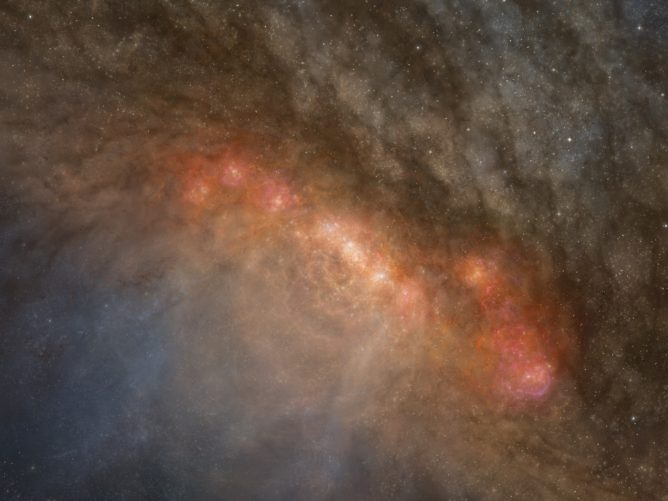Over 100 molecular species discovered in starburst galaxy NGC 253

Using the Atacama Large Millimeter/submillimeter Array (ALMA) in Chile, astronomers observed the center of a nearby starburst galaxy, NGC 253. Located about 10 million light-years away, this galaxy is known for its remarkable rate of star production, significantly outpacing our own Milky Way (Called starburst galaxies).
Following over 300 hours of observation, the researchers found more than one hundred molecular species, a number far surpassing previous detections in extragalactic studies. These include molecules that have been detected for the first time beyond the Milky Way, such as ethanol and the phosphorus-bearing species PN.
This ALMA Comprehensive High-resolution Extragalactic Molecular Inventory (ALCHEMI) survey, led by Sergio Martín of the European Southern Observatory/Joint ALMA Observatory, Nanase Harada of the National Astronomical Observatory of Japan, and Jeff Mangum of the National Radio Astronomy Observatory (NRAO), provides a new understanding of phenomena related to star birth in a starburst galaxy.
The study reveals that high-density molecular gas will likely promote active star formation in this galaxy. The researchers found high concentration of dense molecular gas in NGC 253's center, which is more than ten times that found in the Milky Way, a critical factor driving star formation in this galaxy.
The study suggests that collisions between molecular clouds, driven by the dynamic movements of gas and stars within the galaxy, could aid the compression of molecular clouds into denser ones, fostering conditions conducive to star birth. These shock waves evaporate molecules such as methanol and HNCO, freezing onto icy dust particles. When the molecules evaporate as gas, they become observable by radio telescopes such as ALMA.
Additionally, certain molecules are indicators of active star formation. For instance, complex organic molecules, abundant around young stars, were found in significant quantities in NGC 253, pointing to ongoing star formation, akin to the processes observed around protostars in our galaxy. The study found that the amount of complex organic molecules in the center of NGC 253 is similar to that around protostars in the galaxy.
Further, the study sheds light on the harsh aftermath of star formation, revealing a landscape scarred by supernovae and permeated by cosmic rays. This environment, marked by molecules stripped of electrons by cosmic rays, illustrates the challenges to subsequent star formation posed by the remnants of previous stellar generation.
NGC 253's molecular composition revealed from the enhancement of species such as H3O+ and HOC+ that molecules in this region have had some of their electrons stripped off by cosmic rays at a rate at least 1000 times higher than that near the Solar System, hinting at considerable energy input from supernovae, which makes it difficult for gas to condense to form stars.
Furthermore, the survey doubled the known molecular species outside the Milky Way. By applying a machine-learning technique to the atlas of 44 molecular species, the researchers could identify which molecules can most effectively trace the story of star formation from the beginning to the end.
"With the new updates being performed during this decade to the observatory, known as the Wideband Sensitivity Upgrade (WSU), we will be able to extend this kind of study to fainter and further objects to understand the evolution of chemistry in the Universe," stated Sergio Martín, Principal Investigator of this study, and Head of the Department of Science Operations at ALMA.
- READ MORE ON:
- ALCHEMI survey
- stellar evoultion
- Milky Way
- supernovae










